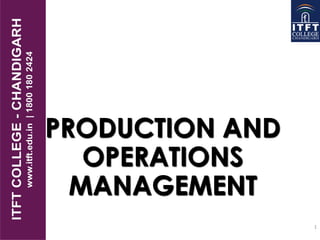ITFT--Production,operations, management
- 2. 2 OBJECTIVES Introduction to Production Function and Operations Management ’é»Mass Production Approach ’é»Toyota Production System (TPS) Approach ’é»Supply Chain Management
- 3. 3 PRODUCTION versus MANUFACTURING ’üČProduction is a Broader Term that Spans both Manufacturing and Services Functions ’üČProduction is the Application of Resources, People and Machinery, to Convert Inputs into Finished Goods and Services
- 4. 4 MASS PRODUCTION Mass Production: Makes Outputs available in Large Quantities at Lower Unit Costs than Individually- Crafted Items Characteristics of Mass Production ’üČLabor Specialization ’üČMechanization ’üČStandardization
- 5. 5 ASSEMBLY LINES Assembly Line first Introduced by Eli Whitney (Cotton Gin Inventor) to build Muskets for the US Government In 1799 Used Ideas of Specialized Labor and Engineering Standards (Tolerances) to produce Assemblies from Parts in Repeatable Manner
- 6. 6 HENRY FORD Introduced Moving Assembly Line: Dramatically Reduced Manufacturing Costs While Delivering Consistent, Low-Priced Product Factory based on Chicago Meat Cutting Plants
- 7. 7 FORD MODEL ŌĆ£TŌĆØ First Produced: October 1908 By 1927, 15,000,000 Produced Any Color so long as itŌĆÖs BlackŌĆ”
- 8. 8 ASSEMBLY LINE BENEFITS ’éź Initially, took 14 hours to Assemble Model T - Mass Production reduced Time to 1 Hour and 33 Minutes ’éź Model TŌĆÖs Price dropped from $1,000 in 1908 to $360 in 1916 ’éź Result was Ford becoming Dominant Automobile Manufacturer and Assembly Line Method as Dominant Production Approach
- 9. 9 FORD ASSEMBLY LINES Assembly Line pulled by Ropes Magneto Assembly
- 10. 10 MASS PRODUCTION MODEL ŌĆ£TŌĆØ ŌĆō Machine that Changed the World ’éź 1914: Ford produced 308,162 cars, more than all 299 other auto manufacturers combined ’éź 1927: Automobile Produced every 24 seconds ’éź Higher volumes ŌåÆ Lower cost ŌåÆ Lower Prices ŌåÆIncreased Sales ŌåÆ Higher Volumes
- 11. 11 MASS PRODUCTION ŌĆ£PUSHŌĆØ Strategy ŌĆō Driven by Inputs and Objectives Control of Raw Materials and Labor plus Profit Goals = Production Rate separate from Customer Demands and Preferences Performance measured by Budget Variances and Quantitative Results (Defects or Unit Costs per Day, Week or Month), not Quality Standards
- 12. 12 MASS PRODUCTION ’é½ Low Product Variety; Small Orders Not Feasible ’é½ Specialized Machinery and Centralized Manufacturing ’é½ ŌĆ£Economies of ScaleŌĆØ ŌĆō High-Speed Sequential Production ’é½ Development Costs Spread Over Large Volume: Low Cost per Unit Produced ’é½ Low-Skill/Low-Wage Work Force ’é½ Large Advertising and Marketing Budgets
- 13. 13 FORD WORKING CONDITIONS Monotony of Assembly Line Work: 300% Turnover ’é½ $2 per Day and a 9-Hour Shift FordŌĆÖs Response to Working Conditions Dilemma ’é½ Increase Pay to $5 per Day and Reduce Shifts from 9 Hours to 8 Hours ŌĆ£The Chain System you have is a Slave Driver. My God, Mr. Ford! My Husband has come Home and Thrown Himself Down and wonŌĆÖt Eat his Supper, HeŌĆÖs so done out. CanŌĆÖt it be Remedied? That $5-a-day is a Blessing; a Bigger One than you Know. But, Oh, They Earn It!ŌĆØ - Wife of Ford Assembly Line Worker
- 14. 14 MASS PRODUCTION Flaws of Mass Production Approach ’é│ Production Levels cannot Stop or Slow: Defects resolved outside Production (Added Costs of Rework) ’é│ Long Changeover Times limits Product Variety ’é│ Erratic Finished Products Inventory Levels ’é│Incentives and 0% Financing
- 16. 16 TOYOTAŌĆÖS ORIGINS 1902 Modification: Loom Stopped Automatically if Thread Broke or Spool Empty - Signal for Attention Result: No Waste from Defective Work and Lower Production Costs Toyoda Automated Loom Works
- 17. 17 TOYOTAŌĆÖS ORIGINS During WWII, Toyoda became Toyota and manufactured Motorcycles and Delivery Trucks After WWII, Japanese Industry needed to re-build
- 18. 18 TOYOTAŌĆÖS ORIGINS Found Mass Production Principles not Applicable: ’é¦ Scale of Japanese Markets ’é¦ Desire for Product Variety ’é¦ Unable to Afford Resources and Inventories 1956 ŌĆō Taiichi Ohno went to US to study FordŌĆÖs Manufacturing Facilities
- 19. 19 TOYOTAŌĆÖS ORIGINS Discovered Production and Operation Methods that ’é¦ Were Linked to Customer Actions: Inventories Replenished by Sales (ŌĆ£PULLŌĆØ Strategy) ’é¦ Delivered Product Variety and Scale ’é¦ Minimized Waste Before returning to Japan, Ohno went to an American Grocery Store
- 20. 20 TOYOTAŌĆÖS ORIGINS Toyota Exports its First Car: The Forgettable ŌĆ£CrownŌĆØ Under-powered and Unstable at Freeway speeds, Production is stopped in 1959
- 21. 21 TOYOTA PRODUCTION SYSTEM In 1961, Toyota adopts ŌĆ£Systems PerspectiveŌĆØ ’üČKAIZEN ŌĆō Continuous Improvement Attitude that Minimizes Waste and Emphasizes High Quality Processes are analyzed to eliminate flaws rather than fixing defective products ’üČWASTE ŌĆō Comprehensive View that includes Time, Resources and Materials ’üČOver-Production ’üČTime Spent Waiting ’üČUnnecessary Movements of Items
- 22. 22 TOYOTA PRODUCTION SYSTEM Waste is anything other than the minimum amount of equipment, materials, parts, space, and workersŌĆÖ time which are absolutely essential to add value to the product. - Shoichiro Toyoda President, Toyota Motor Co.






















